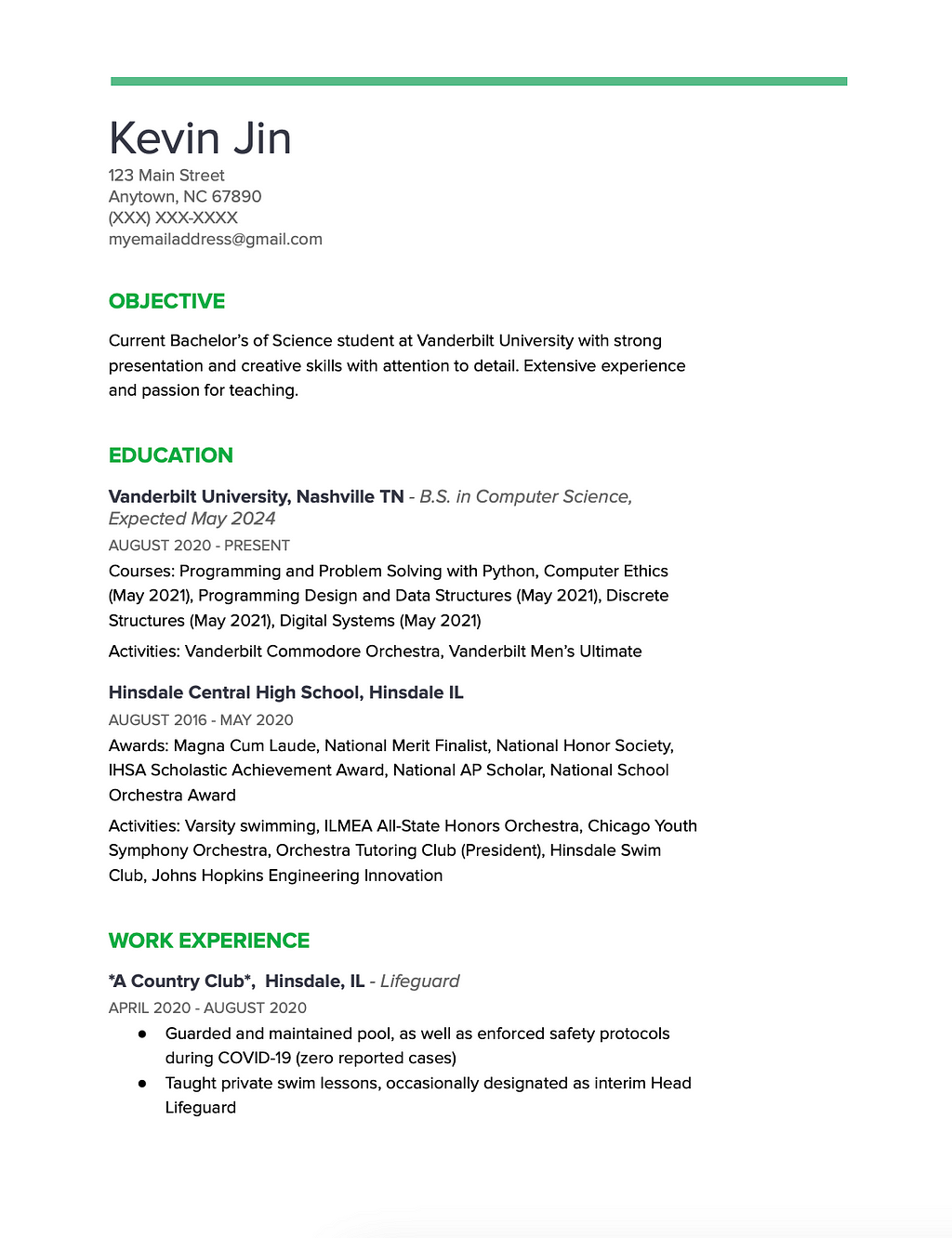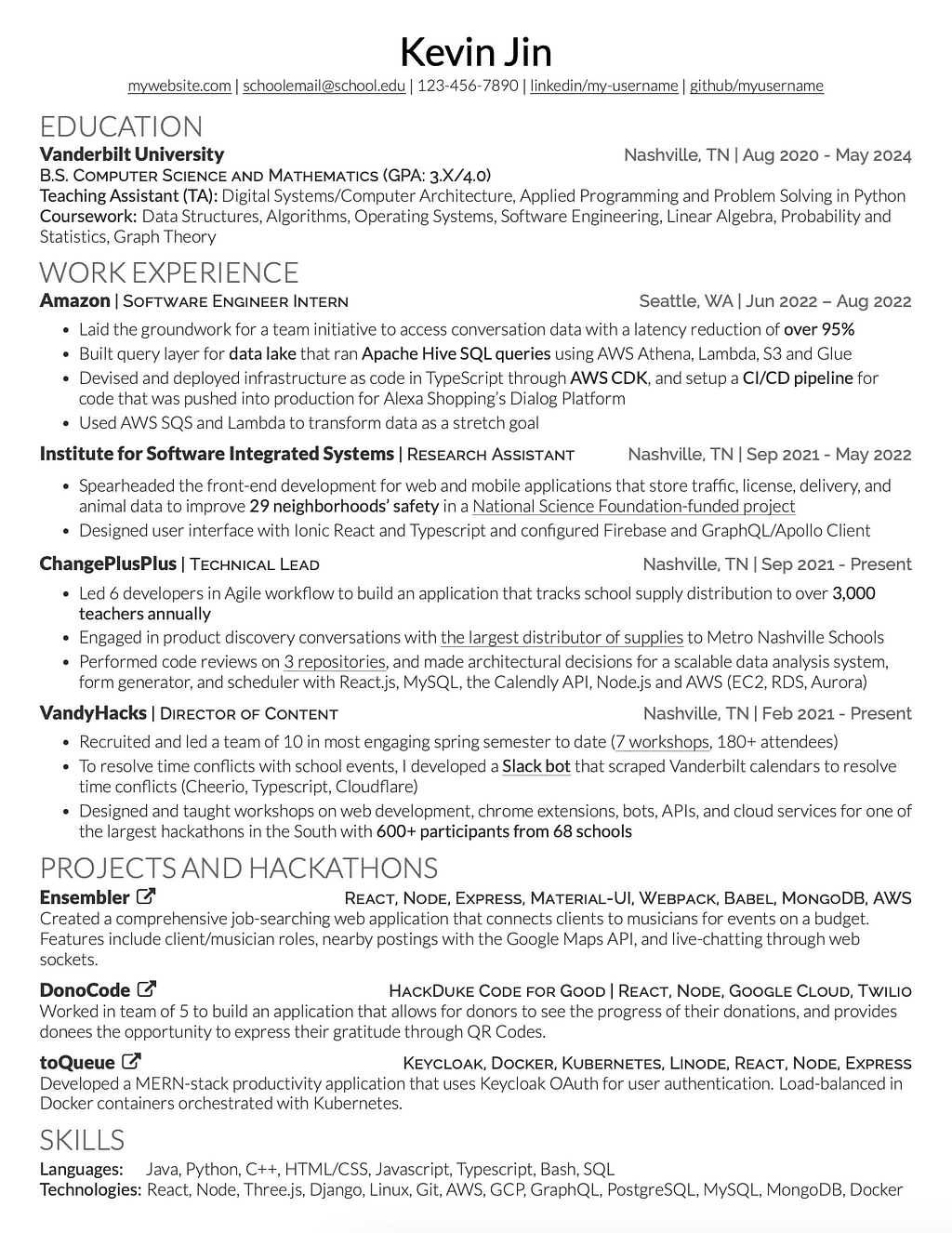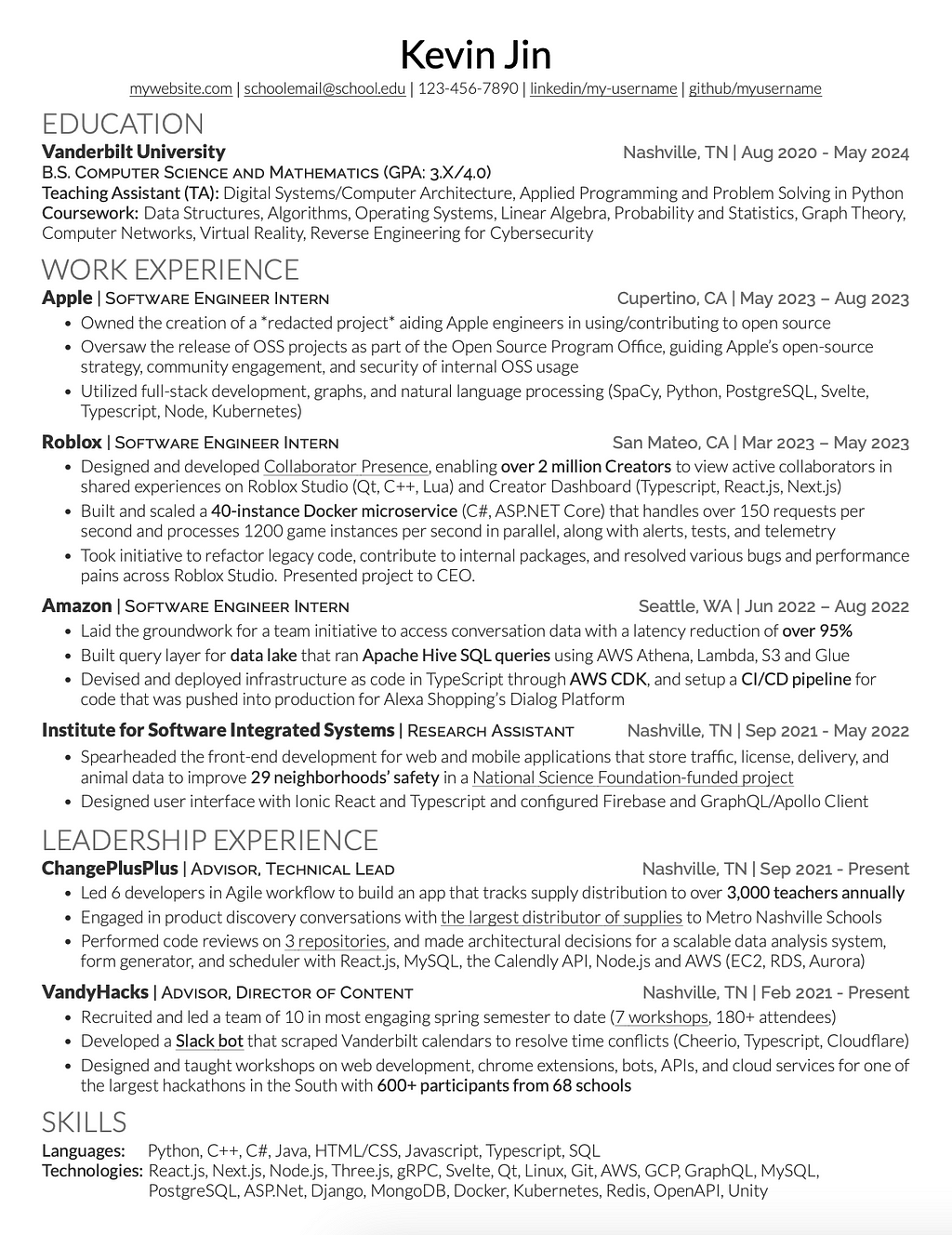This content originally appeared on Level Up Coding - Medium and was authored by Kevin Jin

I’ve reviewed countless resumes from fellow classmates, family friends, and random LinkedIn connections.
To be frank, it can get really exhausting.
That’s because at a certain point, every piece of advice is subjective, and every person you ask will give you conflicting advice.
Should your “Skills” section be at the top or bottom? Should you leave out your mediocre GPA? There’s no wrong answers here — it’s really up to you. Your time is almost always better spent improving the content of your resume by seeking impactful projects and building on the experiences that you have.
I was inspired to make this post after browsing the comment section of Alexander Nguyen’s recent article “The resume that got a software engineer a $300,000 job at Google,” where many were curious about resume templates and CVs that helped software engineers land their first role in “Big Tech.”
Instead of “telling” the techniques that I think are good for a resume, I find it better to “show” how my resume evolved through college from switching majors my freshman year to internships at Amazon, Roblox and Apple by senior year.
Except for sensitive information that could land me in an intense David v. Goliath legal battle with Tim Cook, I tried to redact as little as possible. I’ll be showing how my resume’s content has changed over the years while also highlighting reactions from both recruiters and interviewers.
I hope that my journey will serve as a valuable data point, and that its insights will help you carve your own path towards landing your dream software engineering role!
Freshman Year
(2 Applications, 1 Callback)
We all start somewhere.
I went into college as an undecided engineering major, and was leaning towards studying mechanical engineering. I switched into computer science mid-year after virtually attending VandyHacks, our school hackathon, while in COVID quarantine.
As summer loomed and my friends were looking at research programs and summer jobs, I felt some pressure to look for an engineering-related job as I had no desire to lifeguard again. Repeatedly hollering “WALK!” at little Annabelle as she’s scurrying across the pool deck was not exactly my idea of a fulfilling summer.
Because of COVID restrictions, I never met any computer science majors in classes or anyone who could help me with CS career guidance. Not knowing any better, I found a resume template online and hobbled together what I thought a resume was supposed to look like.

I used this resume to apply to a NASA summer program and a computer science tutor role at Juni Learning. As expected, I never heard back from NASA and was rejected by Juni.
Not landing a role my freshman summer ended up being a blessing in disguise. Over that summer, my passion for programming skyrocketed after being able to dictate my own software curriculum based on my own interests.
I coded for hours every day, building and deploying multiple full-stack development projects. Additionally, I did some free work for a local furniture company by web scraping data and presenting an analysis on competing retail brands, storing this information in a bare-bones PostgreSQL data warehouse.
Sophomore Year
(200+ Applications, 15 Callbacks)
With COVID restrictions lifted and classes fully in-person again, I was finally meeting fellow computer science majors. They introduced me to various research and student organization opportunities — and I said yes to all of them.
Juggling all of these extracurriculars meant throwing my social life in the gutter, but these activities were rewardingly impactful and added a lot of substance to my resume. At long last, I could wave goodbye to filler bullet points about lifeguarding and high school and focus my entire resume on coding.

I landed interviews with a number of tech companies using this resume, and interviewers were impressed with my heavy extracurricular involvement.
In February, I was fortunate enough to receive an offer from Amazon as a software engineer intern in Seattle. My randomly-assigned team developed Alexa Shopping’s dialog platform, where I built out the query layer for a data lake on AWS.
Junior Year
(400+ Applications, 43 Callbacks)
I entered my junior year with the intention of taking a spring gap semester to pursue another internship while my friends were studying abroad.
This meant I was applying to both spring and summer roles over the course of 6 months. My application count was unnaturally high at over 400, as I was applying to the same role at a company over their winter, spring and summer internship seasons. I also wasted a lot of time applying to co-ops because I mistakingly thought that they were the same thing as spring internships (my school did not offer a co-op program).
One day, while twiddling my thumbs in a drab linear algebra lecture about row-echelon form, I decided to do a complete rewrite of my resume.
I had previously taken a graph theory course that required us to use LaTeX for problem sets and papers, and ended up using a LaTeX template for my resume because of its cleanliness.
I was also really proud of the projects I made and organizations I worked with throughout my sophomore year. To highlight these experiences, I filled my resume with links to my work in an effort to be an “open book” to prospective employers about my technical abilities and impact.
This ended up working heavily in my favor when interviewing with startups. Since I was being assessed by engineers who I’d be directly working with, they wanted more assurance of my technical skills than what a fluff-filled resume or asking Two Sum could provide.

I‘m also really grateful that my work at Amazon gave me professional experience in building big data infrastructure on AWS. 2 years later, interviewers are still more interested in my time at Amazon than both of my other internships combined.
AWS cloud infrastructure roles are in high demand across the industry, and there are many SWE-adjacent roles that are looking for cloud-proficient applicants as well. During my fall semester, for instance, I interviewed for a cloud security engineering internship at Netflix without any security experience (made it to the final hiring manager round, but no dice), accidentally got a callback for a cloud research role at Dolby that required applicants to currently pursue a masters degree/PhD (I was predictably humbled in the first manager round), and landed interviews with various bleeding-edge biotech companies that needed data/cloud engineers to process information at the petabyte scale (Neuralink, Enable Medicine, Tempus).
When the interview season was through, I accepted two offers and took off the spring semester to pursue two internships back-to-back. Over that spring, I developed and released a full-stack feature as a software engineer intern on Roblox’s Creator Collaboration team. In the following summer, I worked on multiple projects in different domains as a software engineer intern for Apple’s Open Source Program Office (OSPO).
Senior Year
(80+ Applications, 11 Callbacks)
In the midst of an uncertain job market, it was time to apply for full-time graduate roles. This time around, I decided to maintain the same format and content style of my junior year resume while adding my two most recent internships.
One key difference from my previous resume is that I eliminated the “Projects” section. I found that being asked questions about my personal projects in an interview took valuable time away from discussing my more impactful work.

Having 3 internships in very different domains at “big-name” companies (data infrastructure at Amazon, full stack development at Roblox, natural language processing at Apple) was both a blessing and a curse in the recruitment process.
During phone screens, multiple recruiters were openly skeptical about whether I would even sign an offer if I got one, and interviewers were unconvinced about the direction I wanted to take with my career. Thus, my explanation for why I wanted to work for a company had to be especially well-prepared.
Nevertheless, I am deeply thankful to have had such a diverse range of experiences. Learning skills across various software domains has had a monumental influence on my creative problem-solving process — a process that made me love software engineering in the first place.
Closing Thoughts
So what is the secret to breaking into “Big Tech?” A lot of grit, but beyond that, a lot of luck.
With scores of qualified applicants at the entry and mid levels, landing software interviews at top tech companies is a numbers game where mass-applying for roles will maximize your chances. I was very, very fortunate to have landed that first Amazon interview, and eternally grateful to have been given a project at Amazon involving skills that were in high demand.
You’ll see some get a lucky break without effort, you’ll see others grind really hard and give up before they get a chance. Regardless, if you’re persistent about continually improving yourself, and have a passion for coding that extends beyond unlimited PTO and free laundry, I have no doubt that an opportunity will eventually come your way. I hope that sharing my experiences will provide guidance on shaping your own path, and I wish you all the best on your journey!
From Freelance To FAANG: How My Resume Evolved Through College was originally published in Level Up Coding on Medium, where people are continuing the conversation by highlighting and responding to this story.
This content originally appeared on Level Up Coding - Medium and was authored by Kevin Jin
Kevin Jin | Sciencx (2024-06-20T14:45:44+00:00) From Freelance To FAANG: How My Resume Evolved Through College. Retrieved from https://www.scien.cx/2024/06/20/from-freelance-to-faang-how-my-resume-evolved-through-college/
Please log in to upload a file.
There are no updates yet.
Click the Upload button above to add an update.
